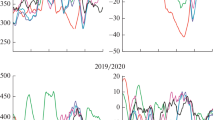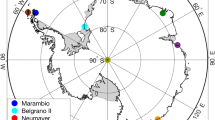Abstract
Winters-springs 2019–2020 and 2010–2011 became the periods of the severest ozone events in the Arctic throughout the satellite era. They stemmed from extremely cold and persistent polar stratospheric cloud (PSC) seasons, conducive to record strong chemical ozone destruction. TEMIS observations indicate that the total ozone (TO) column diverged from long-term norm by 45 to 55% in 2020 and by 37 to 44% in 2011 at Arctic sites; and by 27 to 32% in 2020 and by 27 to 36% in 2011 at midlatitudes. Aura MLS profiles showed that the minimum temperature was 8–13% lower than norm over the Arctic in 2020 and 8–12% lower in 2011. The ozone mixing ratios were 4% of the long-term mean at height of 20 km on March 27, 2020 and 25% at height of 21 km on March 20, 2011 for Eureka; and 7% at 19 km on April 19, 2020 and 24% at 20 km on March 20, 2011 for Ny-Ålesund. The divergences in water vapor and ozone mixing ratios, water vapor mixing ratio and temperature, and ozone mixing ratio and temperature show stronger correlations in 2020 than 2011. The correlations weaken equatorward, until becoming almost insignificant at extra-vortex latitudes.


Similar content being viewed by others
REFERENCES
Rieder, H.E. and Polvani, L.M., Are recent Arctic ozone losses caused by increasing greenhouse gases?, Geophys. Res. Lett., 2013, vol. 40, pp. 4437–4441. https://doi.org/10.1002/grl.50835
Rex, M., Salawitch, R.J., von der Gathen, P., Harris, N.R.P., Chipperfield, M.P., and Naujokat, B., Arctic ozone loss and climate change, Geophys. Res. Lett., 2004, vol. 31, p. L04116. https://doi.org/10.1029/2003GL018844
Rex, M., Salawitch, R.J., Deckelmann, H., von der Gathen, P., Harris, N.R.P., Chipperfield, M.P., Naujokat, B., Reimer, E., Allaart, M., Andersen, S.B., Bevilacqua, R., Braathen, G.O., Claude, H., Davies, J., De Backer, H., Dier, H., Dorokhov, V., Fast, H., Gerding, M., Godin-Beekmann, S., Hoppel, K., Johnson, B., Kyrö, E., Litynska, Z., Moore, D., Nakane, H., Parrondo, M.C., Risley, Jr., A.D., Skrivankova, P., Stübi, R., Viatte, P., Yushkov, V., and Zerefos, C., Arctic winter 2005: Implications for stratospheric ozone loss and climate change, Geophys. Res. Lett., 2006, vol. 33, p. L23808. https://doi.org/10.1029/2006GL026731
Hu, D., Guan, Z., Tian, W., and Ren, R., Recent strengthening of the stratospheric Arctic vortex response to warming in the central North Pacific, Nat. Commun., 2018, no. 9, p. 1697. https://doi.org/10.1038/s41467-018-04138-3
Weber, M., Arosio, C., Feng, W., Dhomse, S.S., Chipperfield, M.P., Meier, A., Burrows, J.P., Eichmann, K., Richter, A., and Rozanov, A., The unusual stratospheric Arctic winter 2019/20: Chemical ozone loss from satellite observations and TOMCAT Chemical Transport Model, J. Geophys. Res.: Atm., 2021, vol. 126, p. e2020JD034386. https://doi.org/10.1029/2020JD034386
Wohltmann, I., von der Gathen, P., Lehmann, R., Maturilli, M., Deckelmann, H., Manney, G.L., Davies, J., Tarasick, D., Jepsen, N., Kivi, R., Lyall, N., and Re, M., Near-complete local reduction of Arctic stratospheric ozone by severe chemical loss in spring 2020, 2020, Geophys. Res. Lett., 2020, vol. 47, p. e2020GL089547. https://doi.org/10.1029/2020GL089547
Kuttippurath, J., Feng, W., Müller, R., Kumar, P., Raj, S., Gopikrishnan, G.P., and Roy, R., Arctic on the verge of an ozone hole?, Atm. Chem. Phys., Discussions [preprint]. https://doi.org/10.5194/acp-2020-1313
Bazhenov, O.E., Nevzorov, A.A., Nevzorov, A.V., Dolgii, S.I., and Makeev, A.P., Disturbance of the stratosphere over Tomsk prior to the 2018 major sudden stratospheric warming: Effect of ClO dimer cycle, Opt. Mem. Neural Networks, 2021, vol. 30, no. 2, pp. 146–156. https://doi.org/10.3103/S1060992X21020065
Rao, J. and Garfinkel, C.I., Arctic ozone loss in March 2020 and its seasonal prediction in CFSv2: A comparative study with the 1997 and 2011 cases, J. Geophys. Res.: Atmos., 2020, vol. 125, p. e2020JD033524. https://doi.org/10.1029/2020JD033524
Van der Ronald, A., Tropospheric emission monitoring Internet service, EGU General Assembly 2010, held 2–7 May (Vienna, Austria, 2010), 9953.
Manney, G.L., Livesey, N.J., Santee, M.L., Froidevaux, L., Lambert, A., Lawrence, Z.D., Millan, L.F., Neu, J.L., Read, W.G., Schwartz, M.J., and Fuller, R.A., Record low Arctic stratospheric ozone in 2020: MLS observations of chemical processes and comparisons with previous extreme winters, Geophys. Res. Lett., 2020, vol. 47, p. e2020GL089063. https://doi.org/10.1029/2020GL089063
Livesey, N.J., Read, W.G., Wagner, P.A., Froidevaux, L., Santee, M.L., Schwartz, M.J., Lambert, A., Manney, G.L., Valle, L.F.M., Pumphrey, H.C., Fuller, R.A., Jarnot, R.F., Knosp, B.W., and Lay, R.R., EOS MLS version 5.0x level 2 and 3 data quality and description document, Technical Report, Jet Propulsion Laboratory D-105336 Rev. A., 2020, available from https://mls.jpl.nasa.gov/publications.
Bazhenov, O.E., Ozone anomaly during Winter–Spring 2019–2020 in the Arctic and over the North of Eurasia Using Satellite (Aura MLS/OMI) Observations, Atmos. Oceanic Opt., 2021, vol. 4, no. 6, pp. 653–658. https://doi.org/10.1134/S102485602106004X
Inness, A., Chabrillat, S., Flemming, J., Huijnen, V., Langenrock, B., Nicolas, J., Polichtchouk, I., and Razinger, M., Exceptionally low Arctic stratospheric ozone in spring 2020 as seen in the CAMS reanalysis, J. Geoph. Res.: Atmos., 2020, vol. 125, no. 23, p. e2020JD033563. https://doi.org/10.1029/2020JD033563
Solomon, S., Stratospheric ozone depletion: A review of concepts and history, Rev. Geophys., 1999, vol. 37, no. 3, pp. 275–316. https://doi.org/10.1029/1999RG900008
Bazhenov, O.E., Increased humidity in the stratosphere as a possible factor of ozone destruction in the Arctic during the spring 2011 using Aura MLS observations, Int. J. Remote Sens., 2019, vol. 40, no. 9, pp. 3448–3460. https://doi.org/10.1080/01431161.2018.1547449
ACKNOWLEDGMENTS
TO measurements from Geophysical Observatory at Institute of Monitoring of Climatic and Ecological Systems, Siberian Branch, Russian Academy of Sciences, used to calculate the divergences of 2019/2020 and 2010/2011 TOs from multiyear mean, were kindly provided by S.V. Smirnov from Laboratory of Physics of Climatic Systems.
Author information
Authors and Affiliations
Corresponding author
Ethics declarations
The author declares that he has no conflicts of interest.
About this article
Cite this article
Bazhenov, O.E. Comparison of the 2011 and 2020 Stratospheric Ozone Events at Arctic and Northern Eurasian Latitudes Using TEMIS and Aura MLS Data. Opt. Mem. Neural Networks 32, 182–188 (2023). https://doi.org/10.3103/S1060992X23030025
Received:
Revised:
Accepted:
Published:
Issue Date:
DOI: https://doi.org/10.3103/S1060992X23030025




